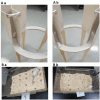Cognitive and anti-inflammatory effects of Palmaria palmata in a schizophrenia mouse model: insights into CREB signaling, Iba-1 expression, and CD4+ cell modulation
- PMID: 40535971
- PMCID: PMC12174456
- DOI: 10.3389/fnins.2025.1551764
Cognitive and anti-inflammatory effects of Palmaria palmata in a schizophrenia mouse model: insights into CREB signaling, Iba-1 expression, and CD4+ cell modulation
Abstract
Background: Schizophrenia is a prevalent mental illness characterized by complex behavioral and emotional disturbances, with its underlying molecular mechanisms yet to be fully elucidated.
Aim: This study aims to examine the neuroprotective effects of Palmaria palmata (Palmaria p.) on cognitive function in a schizophrenia mouse model.
Methods: A total of 28 adult male SWR Swiss mice were used over a 30-day period. The animals were randomly divided into four groups (n = 7): control, cuprizone (CPZ) (0.2% CPZ in chow), CPZ + Palmaria p. (600 μg/kg bw/day via gavage), and Palmaria p. alone. The antioxidant activity of Palmaria p. was assessed using a radical scavenging assay. Behavioral assessments, hippocampal (HC) and frontal cortex (FC) gene expression analyses, and histopathological evaluations were conducted.
Results: Palmaria p. demonstrated remarkable antioxidant activity against CPZ-induced oxidative stress. No notable effects were observed in spatial memory, the novel object recognition test (NORT), or anxiety-related behaviors. In the CPZ-treated group, Iba1 and CREB expression levels increased in both the hippocampus (HC) and frontal cortex (FC). In the CPZ + Palmaria p. group, Iba1 expression was reduced by approximately one-fold in the HC and two-fold in the FC, while CREB expression was decreased by approximately two-fold in both regions compared to the CPZ group, indicating attenuation of neuroinflammation and restoration of neuroplasticity. Immunohistochemical analysis revealed a notable decline in CD4+ expression following Palmaria p. administration, suggesting a decrease in the immunological response induced by CPZ.
Conclusion: The results highlight the potential of Palmaria p. to enhance neuroplasticity and reduce neuronal inflammation associated with schizophrenia.
Keywords: Palmaria palmata; Y maze; anxiety; marble burying test; object recognition memory; red marine algae; schizophrenia; zero maze.
Copyright © 2025 Yousof, Alghamdi, Alqurashi, Alam, Tash, El-Fadeal, Abusikkien and Kaddam.
Conflict of interest statement
The authors declare that the research was conducted in the absence of any commercial or financial relationships that could be construed as a potential conflict of interest.
Figures










Similar articles
-
Mitochondria-targeted antioxidant skq1 reverses functional impairment and histopathological insults in a chronic animal model of multiple sclerosis.Metab Brain Dis. 2025 Aug 22;40(7):249. doi: 10.1007/s11011-025-01676-w. Metab Brain Dis. 2025. PMID: 40844545
-
Zingerone Attenuates Cadmium-Induced Neuroinflammation, Oxidative Stress and Cognitive Deficit on the Prefrontal Cortex of Adult Wistar Rats.J Exp Pharmacol. 2025 Jun 13;17:323-341. doi: 10.2147/JEP.S519571. eCollection 2025. J Exp Pharmacol. 2025. PMID: 40535155 Free PMC article.
-
Modulation of Gut Microbiome Community Mitigates Multiple Sclerosis in a Mouse Model: The Promising Role of Palmaria palmata Alga as a Prebiotic.Pharmaceuticals (Basel). 2023 Sep 25;16(10):1355. doi: 10.3390/ph16101355. Pharmaceuticals (Basel). 2023. PMID: 37895826 Free PMC article.
-
Prevalence and odds of anxiety and depression in cutaneous malignant melanoma: a proportional meta-analysis and regression.Br J Dermatol. 2024 Jun 20;191(1):24-35. doi: 10.1093/bjd/ljae011. Br J Dermatol. 2024. PMID: 38197404
-
Prenatal administration of progestogens for preventing spontaneous preterm birth in women with a multiple pregnancy.Cochrane Database Syst Rev. 2019 Nov 20;2019(11):CD012024. doi: 10.1002/14651858.CD012024.pub3. Cochrane Database Syst Rev. 2019. PMID: 31745984 Free PMC article.
References
-
- Alqurashi G. K., Hindi E. A., Zayed M. A., Abd El-Aziz G. S., Alturkistani H. A., Ibrahim R. F., et al. (2022). The impact of chronic unpredictable mild Stress-induced depression on spatial, recognition and reference memory tasks in mice: behavioral and histological study. Behav. Sci. 12:166. doi: 10.3390/bs12060166, PMID: - DOI - PMC - PubMed
-
- Bancroft J. D., Gamble M. (2013). Theory and practice of histological techniques. 7th Edn. Philadelphia: Churchill Livingstone of Elsevier, 172–186.
-
- Braun A. A., Skelton M. R., Vorhees C. V., Williams M. T. (2011). Comparison of the elevated plus and elevated zero mazes in treated and untreated male Sprague-Dawley rats: effects of anxiolytic and anxiogenic agents. Pharmacol. Biochem. Behav. 97, 406–415. doi: 10.1016/j.pbb.2010.09.013, PMID: - DOI - PMC - PubMed
LinkOut - more resources
Full Text Sources
Research Materials

